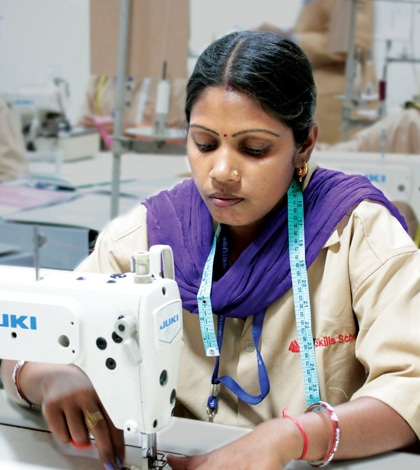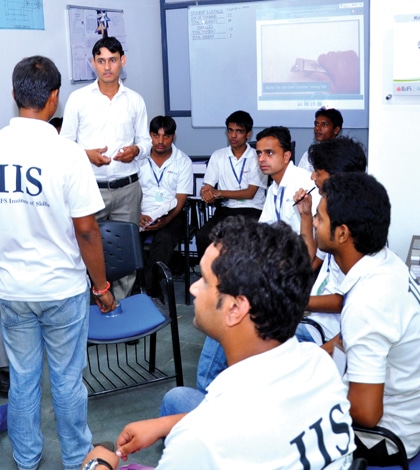
 After steering the BJP-led NDA to power with an absolute majority, Prime Minister Narendra Modi has a tough task ahead to revive the Indian economy, uplift the hundreds of millions of poor and create jobs for the tens of millions of youth and build brand India. K S Narayanan of Elets News Network reports
After steering the BJP-led NDA to power with an absolute majority, Prime Minister Narendra Modi has a tough task ahead to revive the Indian economy, uplift the hundreds of millions of poor and create jobs for the tens of millions of youth and build brand India. K S Narayanan of Elets News Network reports
Our country has earned a reputation for scam India. We will have to transform this into skilled India. There is an urgent need for manpower in the world. Our neighbour China is getting older and we are getting younger. Our priority should be skill development in the youth, Prime Minister Narendra Modi said while replying to the debate on the motion of thanks on President Pranab Mukherjee’s address to Parliament.
“There is a need to have skill, not just certificates,” Modi added.
Demographic Dividends
Emphasis of the new government is well-placed. A population of 1.3 billion with about 0.8 billion in the working age – India in 2020 is surely something the world can look forward to and this is what makes skill development significant for several reasons. According to economic predictions, that time (2020) would be the golden ‘Growth’ era in the demographic dividend. It is estimated that India would not only have enough manpower to meet its own needs, it can help the rest of the world as well. Amidst the glitz and glamour of these numbers, one often chooses to ignore that in today’s knowledge-based economy, the quality of the workforce is more important than its quantity.
There is a growing disconnect between the needs of the employers and the skills that are available in the job market today. This causes workers and companies to miss out on realising their full potential
Skill Deficit
 It is estimated that India would have a skill gap of 75-80 per cent across sectors.
It is estimated that India would have a skill gap of 75-80 per cent across sectors.
According to a survey conducted in March this year by a job portal CareerBuilder India, the current job market is not only frustrating for those looking for employment, but also for businesses with open positions unable to find the right talent.
“The skills gap in India is an issue that is not going away anytime soon,” CareerBuilder India Managing Director Premlesh Machama said. Around 78 per cent of the surveyed employers said they are concerned with the growing skills gap in India, while 57 per cent said they currently have open positions for which they cannot find qualified candidates.
The report further suggests that costs associated with the skills gap can add up quickly and have broader implications for business performance. “There is a growing disconnect between the needs of the employers and the skills that are available in the job market today. This causes workers and companies to miss out on realising their full potential and creates multiple negative consequences for businesses,” Machama added.
Institutional Mechanisms
 To create such an institutional base for skill development in India at the national level, a “Coordinated Action on Skill Development” with three-tier institutional structure consisting of the PM’s National Council on Skill Development, the National Skill Development Coordination Board (NSDCB) and the National Skill Development Corporation (NSDC) was created in early 2008. With the creation of National Skill Development Agency (NSDA), the National Council on Skill Development, the NSDC Board and the Office of the Adviser to Prime Minister on Skill Development have now been subsumed in NSDA, while PM’s National Council on Skill Development was constituted as a Cabinet Committee on Skill Development in 2013.
To create such an institutional base for skill development in India at the national level, a “Coordinated Action on Skill Development” with three-tier institutional structure consisting of the PM’s National Council on Skill Development, the National Skill Development Coordination Board (NSDCB) and the National Skill Development Corporation (NSDC) was created in early 2008. With the creation of National Skill Development Agency (NSDA), the National Council on Skill Development, the NSDC Board and the Office of the Adviser to Prime Minister on Skill Development have now been subsumed in NSDA, while PM’s National Council on Skill Development was constituted as a Cabinet Committee on Skill Development in 2013.
Different stakeholders including India Inc have huge expectations from Modi government to fix the skill deficit.
Welcoming the creation of new skill development ministry, RCM Reddy, Chairman, FICCI Skills Development Forum and Managing Director & CEO, IL&FS Education & Skills expects three issues to be resolved immediately. “Streamline the imple- mentation of skills schemes and programmes between 18 min- istries to attract more professional agencies and private sector partners to join the skilling mission. One of the important areas within this will be focusing on creating uniform funding across ministries and departments with higher incentives for capital expenditure intensive programmes, extend skills development within the scheme framework for the informal sector which could lead to self employment and entrepreneurship and fast track PPP initiatives for setting up of ITIs and Polytechnics”.
Upskilling 500 million by the year 2022 will not only create jobs for the youth but could help India emerge as the global choice for foreign direct investment and a global talent provider besides steering the Indian economy to higher growth trajectory
Co-ordination, hike budgetary allocation
 The Modi government has for the first time created an exclusive ministry to focus on skill development, entrepreneurship, youth affairs & sports and appointed Sarabananda Sonowal, the 51-year-old BJP leader from Assam.
The Modi government has for the first time created an exclusive ministry to focus on skill development, entrepreneurship, youth affairs & sports and appointed Sarabananda Sonowal, the 51-year-old BJP leader from Assam.
Acknowledging the acute skill deficit in the country, Sonowal’s ministry is undertaking a study to determine whether there is need for adopting different models for different states and settting up institutes for skill development immediately after the study is completed.
Co-ordination among several ministries is a must to accelerate the pace of skilling Indian youths. Prime Minister Modi needs to fix the inter-ministerial squabbles as union ministries (Labour, Human Resources and Rural Development) fear losing their turfs and funds as well. Skill development is a massive government programme with annual allocation of about Rs. 5,000 crore. The funds and the work are spread over 11 ministries including HRD, labour and rural development that often end up working at cross purposes.
Take for instance the Rural Development (RD) ministry which received Rs. 1,400 crore in the last budget for its skill programme Aajeevika, which is run by district RD officers by enrolling self-help groups while the Urban development ministry runs similar programmes in the cities and was allocated Rs. 100 crore. UPA-2, near the end of its tenure, had put the finance ministry in charge of coordinating with all ministries on skill development via the national skill development agency. It had set a target to train 11 million youth in 2014-15 and 500 million youth by 2020.
Another issue that will translate the new government’s good intent into action is the hike in budgetary allocation and incentives for those affiliated to sector skill councils.
“The challenge of skilling 500 million by 2022 has not changed. What possibly could have changed is that pace with which we go on year on year. Prime Minister Narendra Modi has used four critical words-‘Skills’, ‘Speed’, ‘Scale’ and Sustainability’. His slogan is ‘Shrameva Jayate’ and he talked about the need to empower people across the country. To convert that vision into intent and execution, we need to step up and accelerate action for going forward. Again, it all depends on budgetary allocation and what we focus on,” Dilip Chenoy, CEO/MD National Skill Development Corporation said in an interview.
If the new government can remove irritants and bottle necks and synergize the efforts and resources to provide a feasible platform for vocational education and skill development, evolve solutions for upskilling 500 million by the year 2022, it will not only create jobs for youth but could help India emerge as the global choice for foreign direct investment and a global talent provider besides steering the Indian economy to higher growth trajectory.




















